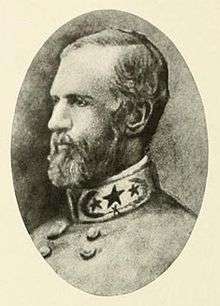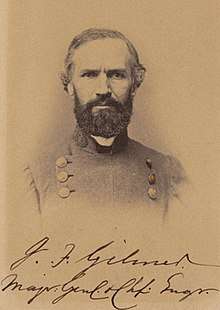Jeremy Francis Gilmer
Jeremy Francis Gilmer (February 23, 1818 – December 1, 1883) was an American soldier, mapmaker, and civil engineer most noted for his service as the Chief Engineer of the Confederate States Army during the American Civil War. As a major general, he oversaw the planning of the elaborate defenses of the city of Atlanta, Georgia.
Jeremy Francis Gilmer | |
|---|---|
 | |
| Born | February 23, 1818 Guilford County, North Carolina |
| Died | December 1, 1883 (aged 65) Savannah, Georgia |
| Allegiance | |
| Service/ | |
| Years of service | 1839–1861 (USA) 1861–1865 (CSA) |
| Rank | Major General (CSA) |
| Battles/wars | Mexican–American War American Civil War
|
| Other work | President of Savannah Gas Company Director and engineer of Georgia Central Railroad |
Early life
Gilmer was born in Guilford County, North Carolina on February 23, 1818.[1] He entered the army corps of engineers as a second lieutenant upon his graduation from the United States Military Academy at West Point, New York on July 1, 1839.[1] He ranked fourth in a graduating class[1] that included future fellow Civil War generals Halleck, Canby, Hunt, and Ord. He was an assistant professor of engineering at West Point until June 1840, when he was reassigned to New York City where he was assistant engineer in the construction of Fort Schuyler in New York Harbor.
Gilmer served in the Mexican War as Chief Engineer of the Army of the West in the New Mexico Territory and helped design and construct Fort Marcy in Santa Fe. He also surveyed battlefields near Mexico City.
Assigned to Georgia, he superintended the improvement of the Savannah River and the construction of Fort Jackson and Fort Pulaski.
Until 1861, he was active in making surveys, constructing fortifications in various locations including San Francisco, California, and executing various river and harbor improvements.
Civil War
Upon the outbreak of the Civil War, he left California, and entered the Confederate service. He was appointed on March 16, 1861 as a Confederate lieutenant of engineers. He resigned from the U.S. Army on June 29, 1861. He soon became chief engineer on the staff of General A. S. Johnston as a lieutenant colonel. Gilmer was severely wounded in his right arm at the Battle of Shiloh, where Johnston was killed.[1] After his recovery in Georgia, Gilmer was promoted to chief engineer of the Department of Northern Virginia in early August 1862. He was stationed at Richmond with the rank of brigadier general.

On August 25, 1863, Gilmer was given a temporary appointment to the grade of major general.[2] He was appointed Chief of the Engineer Bureau for the Confederacy. He spent time overseeing the defenses of Charleston, South Carolina, although he was still plagued by recurring health problems from his Shiloh wound. Concerned that the vital rail and manufacturing center of Atlanta would be targeted by Union forces, he commissioned Atlanta businessman and entrepreneur Lemuel P. Grant to develop a plan to ring the city with forts and earthworks along all the key approaches. These elaborate defenses would prove difficult to seize in frontal assaults, forcing the Union army to lay siege to Atlanta in the summer of 1864.
Gilmer helped improve the defenses of Mobile, Alabama, in June and July. He returned to Richmond in July 1864 and spent the rest of the war there as Chief of the Engineer Bureau.
Post-War career
After the war, from 1867–1883 Gilmer was president and engineer of the Savannah Gas Company.[1] He was also a director of the Georgia Central Railroad.
Death
Jeremy F. Gilmer died from heart disease in Savannah, Georgia, and is buried in the city's Laurel Grove Cemetery.[1]
- This article incorporates text from a publication now in the public domain: Gilman, D. C.; Peck, H. T.; Colby, F. M., eds. (1905). New International Encyclopedia (1st ed.). New York: Dodd, Mead. Missing or empty
|title=(help)
Notes
- Eicher, John H., and David J. Eicher, Civil War High Commands. Stanford: Stanford University Press, 2001. ISBN 978-0-8047-3641-1. p. 598.
- Eicher, 2001 p. 598 classifies Gilmer as a "might of been" because his appointment was not confirmed by the Confederate Senate. On the other hand, former Confederate Brigadier General Marcus Wright in his 1911 compilation (Wright, Marcus J., General Officers of the Confederate Army: Officers of the Executive Departments of the Confederate States, Members of the Confederate Congress by States. Mattituck, NY: J. M. Carroll & Co., 1983. ISBN 0-8488-0009-5. First published 1911 by Neale Publishing Co.) cites an early Confederate law which allowed the Confederate President to appoint temporary generals of volunteers for specific assignments without being subject to confirmation by the Confederate Senate as the basis for Gilmer's appointment to a temporary major general. At page 42, Wright lists two generals in this category and does not show a confirmation date for Gilmer. (The other, Joseph Wheeler later received a permanent appointment.) Wright states: "Authorized by Act of Congress of May 21, 1861, as follows: 'That the President shall be authorized to confer temporary rank and command, for service with volunteer troops, on officers of the Confederate Army; the same to be held without prejudice to their positions in said army, and to have effect only to the extent and according to the assignment made in general order.'" Other sources, such as Warner and Sifakis, list Gilmer as a temporary major general, having been promoted directly from colonel.
References
- Eicher, John H., and David J. Eicher, Civil War High Commands. Stanford: Stanford University Press, 2001. ISBN 978-0-8047-3641-1.
- Sifakis, Stewart. Who Was Who in the Civil War. New York: Facts On File, 1988. ISBN 978-0-8160-1055-4.
- Warner, Ezra J. Generals in Gray: Lives of the Confederate Commanders. Baton Rouge: Louisiana State University Press, 1959. ISBN 978-0-8071-0823-9.
- Wright, Marcus J., General Officers of the Confederate Army: Officers of the Executive Departments of the Confederate States, Members of the Confederate Congress by States. Mattituck, NY: J. M. Carroll & Co., 1983. ISBN 0-8488-0009-5. First published 1911 by Neale Publishing Co.
External links
| Wikisource has original works written by or about: Jeremy Francis Gilmer |
- Gilmer photo gallery at the Wayback Machine (archived February 8, 2008)
- Gilmer Civil War Maps Collection at the University of North Carolina